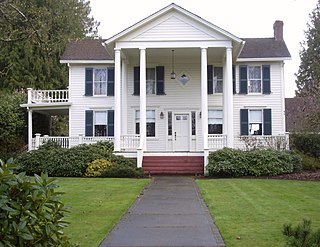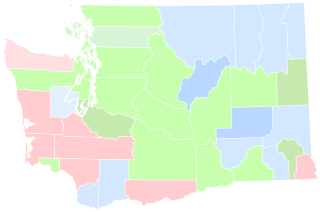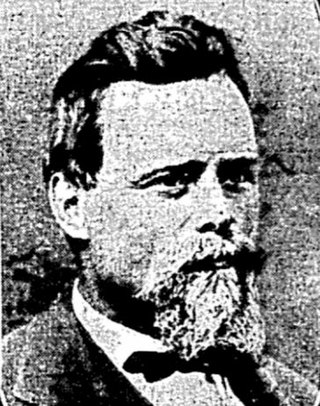
Columbia County is a county located in the U.S. state of Washington. As of the 2020 census, the population was 3,952, making it the second-least populous county in Washington. The county seat and largest city is Dayton. The county was created out of Walla Walla County on November 11, 1875, and is named after the Columbia River. Columbia County is included in the Walla Walla, WA Metropolitan Statistical Area.

The Whitman massacre was the killing of American missionaries Marcus and Narcissa Whitman, along with eleven others, on November 29, 1847. They were killed by a small group of Cayuse men who suspected that Whitman had poisoned the 200 Cayuse in his medical care during an outbreak of measles that included the Whitman household. The killings occurred at the Whitman Mission at the junction of the Walla Walla River and Mill Creek in what is now southeastern Washington near Walla Walla. The massacre became a decisive episode in the U.S. settlement of the Pacific Northwest, causing the United States Congress to take action declaring the territorial status of the Oregon Country. The Oregon Territory was established on August 14, 1848, to protect the white settlers.
The Cayuse War (1847-1855) was an armed conflict between the Cayuse people of the Northwestern United States and settlers, backed by the U.S. government. The conflict was triggered by the Whitman massacre of 1847, where the Cayuse attacked a missionary outpost in response to a deadly measles epidemic that they believed was caused by Marcus Whitman. Over the next few years, the Provisional Government of Oregon and later the United States Army battled the Native Americans east of the Cascades. This was the first of several wars between the Native Americans and American settlers in that region that would lead to the negotiations between the United States and Native Americans of the Columbia Plateau, creating several Indian reservations.

Tiloukaikt (d.1850) was a Native American leader of the Cayuse tribe in the northwestern United States. He was involved in the Whitman Massacre and was a primary leader during the subsequent Cayuse War.

The Barlow Road is a historic road in what is now the U.S. state of Oregon. It was built in 1846 by Sam Barlow and Philip Foster, with authorization of the Provisional Legislature of Oregon, and served as the last overland segment of the Oregon Trail. Its construction allowed covered wagons to cross the Cascade Range and reach the Willamette Valley, which had previously been nearly impossible. Even so, it was by far the most harrowing 100 miles (160 km) of the nearly 2,000-mile (3,200 km) Oregon Trail.

Walter Marcus Pierce was an American politician, a Democrat, who served as the 17th Governor of Oregon and a member of the United States House of Representatives from Oregon's 2nd congressional district. A native of Illinois, he served in the Oregon State Senate before the governorship, and again after leaving the U.S. House. Pierce was an anti-Catholic supporter of compulsory public education and signed a law banning parochial schools, resulting in lawsuits and the United States Supreme Court case of Pierce v. Society of Sisters. He was also a eugenicist and supported Prohibition. He advocated unsuccessfully for a state income tax and vehicle license fee.

Samuel Kimbrough Barlow was a pioneer in the area that became the U.S. state of Oregon, and was key in establishing the Barlow Road, the most widely chosen final segment to the Oregon Trail.

General Joel Palmer was an American pioneer of the Oregon Territory in the Pacific Northwest region of North America. He was born in Upper Canada, and spent his early years in New York and Pennsylvania before serving as a member of the Indiana House of Representatives.

Peter Grant Stewart was a jeweler and pioneer of the Oregon Country in what later became the U.S. states of Oregon and Washington. A native of New York state, he traveled the Oregon Trail to the Willamette Valley and settled first in Oregon City and later in what became Washington. He was served on the Second Executive Committee of the Provisional Government of Oregon, and his homesite became part of Fort Canby at the mouth of the Columbia River.

John Langdon Rand was an American politician and jurist in the state of Oregon. He served as the 22nd Chief Justice of the Oregon Supreme Court. Overall he was on Oregon’s highest court from 1921 to 1942 serving as chief justice three times. A native of New Hampshire, he served in the Oregon State Senate prior to his judicial career.

The Palmer House is the historic residence of Oregon pioneer Joel Palmer (1810–81), who co-founded Dayton, Oregon, United States.
Henry A. G. Lee was a soldier and politician in Oregon Country in the 1840s. A member of Virginia's Lee family, he was part of the Fremont Expedition and commanded troops during the Cayuse War in what became the Oregon Territory. He also was a member of the Oregon Provisional Government and the second editor of the Oregon Spectator.
The Oregon Superintendent of Indian Affairs was an official position of the U.S. state of Oregon, and previously of the Oregon Territory, that existed from 1848 to 1873.

Franklin was a coal mining town located in east King County, Washington, near the current so-called Hanging Gardens on the Green River, about 1 mile (1.6 km) east of Black Diamond.
William Craig was an American frontiersman and trapper. He left his Virginia home as a young man and headed west, after allegedly killing a man in self-defense. He trapped with the Sublettes and Jedediah Smith in the Blackfoot country until he joined Joseph R. Walker's California Expedition of 1833–34.

Elgin Victor Kuykendall (1870–1958) was an American lawyer, judge, and politician in the state of Washington in the United States. For several years the chairman of the state committee of the Republican Party of Washington, Kuykendall was first elected to the Washington State Senate in November 1916 and re-elected to a second term two years later. Kuykendall was appointed a judge of the Washington State Superior court in December 1924 and remained in that capacity until his retirement in December 1949. In his twilight years Kuykendall also pursued the avocation of regional historian, ultimately publishing two works on the history of Southeastern Washington state as well as his memoirs.
The Walla Walla expeditions were organized during the mid-nineteenth century to enrich the Sahaptian peoples of the Columbian Plateau with cattle purchased in Alta California. Among the first expedition was Walla Walla leader Piupiumaksmaks, Garry of the Spokanes and Cayuse headman Tawatoy. They arrived at New Helvetia in 1844. A confrontation erupted with the son of Piupiumaksmaks, Toayahnu, being killed by an American. A second expedition was organized, returning to New Helvetia in 1846, where two thousand cattle was purchased. When the expedition returned to the Columbian Plateau, members were ill with measles. The disease was consequently spread across the Pacific Northwest and was a major cause of the Whitman massacre.

The 1912 United States presidential election in Washington took place on November 5, 1912, as part of the 1912 United States presidential election. Voters chose seven representatives, or electors, to the Electoral College, who voted for president and vice president.

Cyrus Y. Jacobs was a grain mill owner, distiller, and merchant in Boise, Idaho. He served as mayor of Boise City 1879–1880.

The Washington Secretary of State election, 2020, was held on November 3, 2020. Incumbent Republican Kim Wyman won reelection over Democratic nominee Gael Tarleton, the two having received the most votes in an August 2020 primary election. Wyman became the only Republican to hold statewide office in Washington and the entire West Coast. As of 2025, this was the last time a Republican won a statewide election in Washington.

















